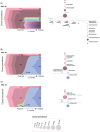Genetic evolution and relapse-associated mutations in adult T-cell acute lymphoblastic leukemia patients treated in PETHEMA trials
- PMID: 40420999
- PMCID: PMC12104817
- DOI: 10.1002/hem3.70148
Genetic evolution and relapse-associated mutations in adult T-cell acute lymphoblastic leukemia patients treated in PETHEMA trials
Abstract
Relapse is the main cause of treatment failure in T-cell acute lymphoblastic leukemia (T-ALL). Despite this, data from adult T-ALL patients treated with specific chemotherapeutic regimens that examine predictive markers and describe relapse mechanisms are scarce. In this study, we studied 74 paired diagnosis-relapse samples from 37 patients homogeneously treated with three consecutive measurable residual disease-oriented trials to identify genetic determinants involved in relapse in adult T-ALL. Analysis of single-nucleotide variants and copy number alterations consistently found N/KRAS mutations (20% relapsed cases) at diagnosis and at relapse (resistance profile). N/KRAS mut patients frequently relapse early during consolidation treatment. Relapse-specific mutations in NT5C2, NR3C1, SMARCA4, and TP53 (40% relapse cases) were not detected at diagnosis by conventional molecular techniques (relapse profile). However, single-cell-based analysis revealed a very minor clone containing the NT5C2(p.R367Q) variant at diagnosis. Patients with the NT5C2(p.R367Q) variant mostly relapse later during maintenance treatment. Tracking the NT5C2 variant by digital PCR confirm the expansion of the NT5C2 clone at maintenance treatment. Overall, our exploratory analysis suggests a role for these genetic events, most of which have already been described in pediatric cases, driving resistance associated to specific chemotherapeutic agents, contributing to the relapse of a high proportion of adult T-ALL patients (60%).
© 2025 The Author(s). HemaSphere published by John Wiley & Sons Ltd on behalf of European Hematology Association.
Conflict of interest statement
The authors declare no conflicts of interest.
Figures




References
-
- Huguet F, Chevret S, Leguay T, et al. Intensified therapy of acute lymphoblastic leukemia in adults: report of the randomized GRAALL‐2005 clinical trial. J Clin Oncol. 2018;36(24):2514‐2523. - PubMed
-
- Ribera J‐M, Morgades M, Ciudad J, et al. Chemotherapy or allogeneic transplantation in high‐risk Philadelphia chromosome‐negative adult lymphoblastic leukemia. Blood. 2021;137(14):1879‐1894. - PubMed
-
- Rowntree CJ, Kirkwood AA, Clifton‐Hadley L, et al. First analysis of the UKALL14 randomized trial to determine whether the addition of nelarabine to standard chemotherapy improves event free survival in adults with T‐cell acute lymphoblastic leukaemia (CRUK/09/006). Blood. 2021;138(suppl 1):366.
-
- Beldjord K, Chevret S, Asnafi V, et al. Oncogenetics and minimal residual disease are independent outcome predictors in adult patients with acute lymphoblastic leukemia. Blood. 2014;123(24):3739‐3749. - PubMed
-
- Petit A, Trinquand A, Chevret S, et al. Oncogenetic mutations combined with MRD improve outcome prediction in pediatric T‐cell acute lymphoblastic leukemia. Blood. 2018;131(3):289‐300. - PubMed
LinkOut - more resources
Full Text Sources
Research Materials
Miscellaneous
